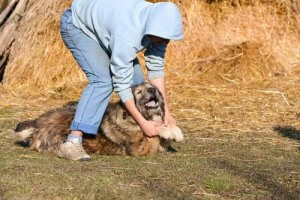Dogs Can Also Be Victims of Domestic Violence

Although violence against women is being denounced more and more, and many cases come out into the open, there is still an aspect of this crime that remains in the shadows. It’s to do with the violence that pets under the same roof can also suffer. Animals can also be victims of domestic violence.
Pets, the other victims of domestic violence

Aggressors can often use pets as a tool for threats or coercion. The dog, or cat, becomes an object of revenge and the person uses them to gain control over the partner. Children or other people in the family group can also be used in this way.
This can be one of the reasons why women often delay leaving the house. It could be that she fears the reprisals that her furry friend could suffer.
Pets are usually a great emotional support for these women. For that reason they don’t want to be separated.
Many victims of domestic violence even refuse to go into shelters for battered women. Why? Because these places don’t usually allow animals to enter.
Pets that live in a home with domestic violence are also often victims of the same violence.
The relationship between domestic violence and animal abuse
In the United States around the mid ’90s, people carried out research on this topic. The researchers found evidence on a phenomenon that we were never aware of before. They found that animal abuse was also a way of committing violence against the partner and against other members of the family.
Some of the conclusions of the studies were:
- 71% of the women that went to a women’s shelter and had a pet said that their partner had hurt, threatened or killed the animal as revenge or to gain psychological control.
- 87% of these occurrences happened in front of the woman. And 75% occurred in front of the children.
- Between 25 and 54% of the women that suffer from domestic violence don’t leave their home. They worry, thinking about what could happen to their dog or cat if they leave.
More details on family violence and animal abuse
The DOMPET study has revealed that in Latin America and in Spain, 79.3% of animal shelters recognize a link between family violence and animal abuse.
Also, 37.9% of these establishments said that between 25 and 50% of the dogs and cats they receive were mistreated in the homes where they used to live.
On the other hand, 61.3% of shelters for battered women allow female victims of domestic violence to visit their pets in nearby shelters.
Looking to include pets in protection measures
Is there any good news? Yes, there is! The experts that attend to women who have suffered domestic violence are paying attention. They are starting to realize more and more that the abuse of animals is an early warning sign of domestic violence.
That’s why the institutions that care for these cases are viewing it as more and more fundamental to include pets in protection measures. And, furthermore, they are getting women to take responsibility for ownership of the animal.
It’s also becoming a basic need for women’s shelters to be able to receive animals as well. Or at least for alternatives to be available in the case of women not wanting to leave their pets behind, to the mercy of the violent partner.
An alternative for animal victims of domestic violence

In Spain and Latin America, the VioPet program is in operation. It’s an organization that contributes to finding either temporary or permanent homes for domestic animal victims of family violence. They find homes where the animals can be safe.
As part of their work, VioPet prioritizes cases of need so that women with pets can go to a shelter together with their animal. The goal is to try to avoid suffering on the part of both the woman and her pet, due to separation anxiety. This program also aims to place the women and pets in a shelter or home that can’t easily be located by their aggressor.
This initiative was started by the organization GEVHA (Group for the Study of Violence towards Humans and Animals). This is part of the SAF-T Program, created by Allie Phillips. Ms Phillips is the district attorney and director of the Animal and Child Abuse area of the National District Attorney’s Association, in the United States.
Although violence against women is being denounced more and more, and many cases come out into the open, there is still an aspect of this crime that remains in the shadows. It’s to do with the violence that pets under the same roof can also suffer. Animals can also be victims of domestic violence.
Pets, the other victims of domestic violence

Aggressors can often use pets as a tool for threats or coercion. The dog, or cat, becomes an object of revenge and the person uses them to gain control over the partner. Children or other people in the family group can also be used in this way.
This can be one of the reasons why women often delay leaving the house. It could be that she fears the reprisals that her furry friend could suffer.
Pets are usually a great emotional support for these women. For that reason they don’t want to be separated.
Many victims of domestic violence even refuse to go into shelters for battered women. Why? Because these places don’t usually allow animals to enter.
Pets that live in a home with domestic violence are also often victims of the same violence.
The relationship between domestic violence and animal abuse
In the United States around the mid ’90s, people carried out research on this topic. The researchers found evidence on a phenomenon that we were never aware of before. They found that animal abuse was also a way of committing violence against the partner and against other members of the family.
Some of the conclusions of the studies were:
- 71% of the women that went to a women’s shelter and had a pet said that their partner had hurt, threatened or killed the animal as revenge or to gain psychological control.
- 87% of these occurrences happened in front of the woman. And 75% occurred in front of the children.
- Between 25 and 54% of the women that suffer from domestic violence don’t leave their home. They worry, thinking about what could happen to their dog or cat if they leave.
More details on family violence and animal abuse
The DOMPET study has revealed that in Latin America and in Spain, 79.3% of animal shelters recognize a link between family violence and animal abuse.
Also, 37.9% of these establishments said that between 25 and 50% of the dogs and cats they receive were mistreated in the homes where they used to live.
On the other hand, 61.3% of shelters for battered women allow female victims of domestic violence to visit their pets in nearby shelters.
Looking to include pets in protection measures
Is there any good news? Yes, there is! The experts that attend to women who have suffered domestic violence are paying attention. They are starting to realize more and more that the abuse of animals is an early warning sign of domestic violence.
That’s why the institutions that care for these cases are viewing it as more and more fundamental to include pets in protection measures. And, furthermore, they are getting women to take responsibility for ownership of the animal.
It’s also becoming a basic need for women’s shelters to be able to receive animals as well. Or at least for alternatives to be available in the case of women not wanting to leave their pets behind, to the mercy of the violent partner.
An alternative for animal victims of domestic violence

In Spain and Latin America, the VioPet program is in operation. It’s an organization that contributes to finding either temporary or permanent homes for domestic animal victims of family violence. They find homes where the animals can be safe.
As part of their work, VioPet prioritizes cases of need so that women with pets can go to a shelter together with their animal. The goal is to try to avoid suffering on the part of both the woman and her pet, due to separation anxiety. This program also aims to place the women and pets in a shelter or home that can’t easily be located by their aggressor.
This initiative was started by the organization GEVHA (Group for the Study of Violence towards Humans and Animals). This is part of the SAF-T Program, created by Allie Phillips. Ms Phillips is the district attorney and director of the Animal and Child Abuse area of the National District Attorney’s Association, in the United States.
This text is provided for informational purposes only and does not replace consultation with a professional. If in doubt, consult your specialist.








